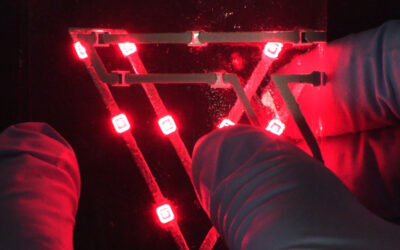The Semiconductor Research Corporation (SRC) and the National Institute of Standards and Technology (NIST) have awarded The University of Texas at Austin a five-year, $7.8 million nanoelectronics award.
The award will be used to develop novel, ultra-low-power transistor research at the South West Academy of Nanoelectronics (SWAN) 2.0 at the Cockrell School of Engineering. This is the second such award from the SRC and NIST collaboration. In all, SRC-NIST awarded three multi-university research centers for the second phase of its Nanoelectronics Research Initiative (NRI). The initiative includes participants from the semiconductor industry including IBM, Intel, Micron Technology, GLOBALFOUNDRIES and Texas Instruments.
“SWAN 2.0 is a tremendous vote of confidence in our faculty and students for their innovative research on advanced technology,” said Gregory L. Fenves, dean of the Cockrell School of Engineering. “The SRC-NIST award is an investment that will pay off many times with revolutionary energy-efficient mobile devices and the next generation of manufacturing, all of which will improve society and the economic competitiveness of the U.S.”
SWAN 2.0 will use the award to develop an ultra-low-power transistor, a building block of modern electronic devices, said Sanjay Banerjee, director of the center. SWAN 2.0 is headquartered at the Microelectronics Research Center, which is located at the J.J. Pickle Research Campus in Northwest Austin.
“We’ve developed novel transistor concepts, which if successful, would consume about 0.1 percent of the energy of existing transistors,” Banerjee said. “There is a critical need for a radically new type of transistor to perform computing functions with very low power. There could be potential applications in mobile devices, and it could also lead to advanced nanoelectronics manufacturing research in the U.S.”
As part of the award, SWAN 2.0 is working with 16 professors at seven universities: The University of Texas at Austin, The University of Texas at Dallas, Texas A&M University, North Carolina State University, Harvard University, Stanford University and University of California at San Diego. UT Austin professors Leonard F. Register, Emanuel Tutuc, Rodney S. Ruoff and Deji Akinwande from the Cockrell School, and Allan MacDonald from the College of Natural Sciences are collaborating on the project.
The researchers are working on nanoelectronics architecture and two-dimensional materials, such as graphene, to solve the need for energy-efficient transistors for mobile computing and other technologies.
Today, electronics consume a substantial portion of worldwide energy, and that use is expected to grow. Electronic devices account for about 15 percent of household electricity consumption, and more than half of the global population subscribes to a mobile phone service, according to the International Energy Agency, an independent agency made up of 28 member countries.
SWAN was one of three centers created in 2006 by SRC-NRI with the intention of finding a replacement to conventional metal oxide semiconductor field effect transistors.
Additionally, the Texas Emerging Technology Fund has provided significant funding for SWAN, playing an instrumental role in establishing SWAN’s infrastructure and enabling it to realize its vision through a $10.5 million award. Since its inception, SWAN has received a total of $36.7 million from SRC-NIST, the state of Texas and the University of Texas System.
NRI 2.0 is the successor to an earlier multiyear collaboration between NRI and NIST that focused on the long-term goal of developing the next logic switch, or the basic logic elements that serve as the building blocks of electronics devices.
SRC is the world’s leading university-research consortium for semiconductors and related technologies. The Nanoelectronics Research Corporation, a subsidiary of SRC, manages the NRI-NIST collaboration.
“NIST collaborations with the NRI are one of the fastest ways to move pre-competitive technology forward,” said Patrick Gallagher, director of the NIST and under secretary of commerce for standards and technology. “We’re excited to see what innovative nanoelectronic devices and concepts the next phase of the partnership with SRC will produce.”
Source: University of Texas
















